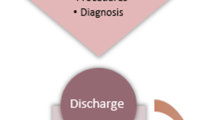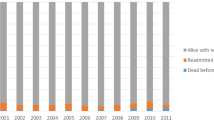Abstract
Objective
To investigate factors that influence hospital readmissions of elderly patients and to construct a robust hospital readmissions predictive model.
Design
Each hospitalised patient was interviewed and medical, demographic and socioeconomic data were obtained from their medical charts. These patients were followed up prospectively for 1 year post discharge with all unplanned readmissions to general medical (including cardiology) wards during this time period recorded. Univariate analysis (chi-squared) was used to identify variables that had at least a minimal association with one or more unplanned readmissions 12 months post discharge (p < 0.25). These were entered into backward stepwise elimination logistic regression analysis (model entry set at p = 0.05). Examination of the significance of the log-likelihood ratio test for each variable determined its contribution to the model.
Patients
Data from a total of 487 elderly patients (≥65 years of age) with non-elective admissions to general medicine wards were used to refine the readmissions model. The refined model was then validated using similar data retrospectively collected from medical charts regarding 732 elderly patients (≥65 years of age).
Results
Multivariate logistic regression analysis yielded a nine-variable model, which contained both predictive and protective variables for one or more readmissions 12 months post discharge from hospital. This model had a specificity of 79.3%, sensitivity of 60.0% and overall accuracy of 71.2% (cut-off point of p = 0.5). When the model was applied to the validation population, an overall percentage accuracy in classification of 65.2% was obtained.
Conclusions
This refined and validated hospital readmissions predictive model could be used by healthcare professionals to help identify vulnerable patients upon admission to hospital, and to put in place a comprehensive discharge planning process.





Similar content being viewed by others
References
Waite K, Oddone E, Weinberger M, et al. Lack of association between patients’ measured burden of disease and risk for hospital readmission. J Clin Epidemiol 1994; 47: 1229–36
Neill J, Williams J. Leaving hospital: elderly people and their discharge to community care. National Institute for Social Work Research Unit Report to the Department of Health. London: HMSO, 1992
Satish S, Winograd CH, Chavez C, et al. Geriatric targeting criteria as predictors of survival and health care utilization. J Am Geriatr Soc 1996; 44: 914–21
Evans RL, Hendricks RD, Lawrence KV, et al. Identifying factors associated with health care use: a hospital-based risk-screening index. Soc Sci Med 1998; 27: 947–54
Reuben DB, Wolde-Tsadik G, Pardamean B, et al. The use of targeting criteria in hospitalised HMO patients; results from the demonstration phase of the hospitalised older persons’ evaluation (HOPE) study. J Am Geriatr Soc 1992; 40: 482–8
Boult C, Dowd B, McCaffrey D, et al. Screening elders for risk ofhospital admission. J Am Geriatr Soc 1993; 41: 811–7
McElnay JC, McCallion CR, Al-Deagi F, et al. Hospital read-missions of elderly patients: a predictive model. Proceedings of ESCP Drug Information Conference; 1997, 39
Blaylock A, Cason CL. Discharge planning: predicting patients’ needs. J Gerontol Nurs 1992; 18: 5–10
Bull MJ. A discharge planning questionnaire for clinical practice. Appl Nurs Res 1994; 7: 193–9
Evans RL, Hendricks RD. Evaluating hospital discharge planning: a randomised clinical trial. Med Care 1993; 31: 358–70
Reuben DB, Borok GM, Wolde-Tsadik G, et al. A randomised trial of comprehensive geriatric assessment in the care of hospitalised patients. New Engl J Med 1995; 332: 1345–9
Boult L, Boult C, Pirie P, et al. Test-retest reliability of a questionnaire that identifies elders at risk for hospital admission. J Am Geriatr Soc 1994; 42: 707–11
Muckart DJJ, Bhagwanjee S, Gouws E. Validation of an outcome prediction model for critically ill trauma patients without head injury. J Trauma 1997; 43: 934–9
Hosmer DW, Lemeshow S. Applied logistic regression: Wiley series in probability and mathematical statistics. New York: John Wiley & Sons, 1989
Colledge NR, Ford MJ. The early hospital readmission of elderly people. Scott Med J 1994; 39: 51–2
Andrews K. Relevance of readmission of elderly patients discharged from a geriatric unit. J Am Geriatr Soc 1986; 34: 5–11
Runciman P, Currie CT, Nicol M, et al. Discharge of elderly patients from an accident and emergency department: evaluation of health visitor follow-up. J Adv Nurs 1996; 24: 711–8
Col N, Fanale JE, Kronholm P. The role of medication non-compliance and adverse drug reactions in hospitalisations of the elderly. Arch Intern Med 1990; 150: 841–5
Stewart RB, Cooper JW. Polypharmacy in the aged: practical solutions. Drugs Aging 1994; 4: 449–61
Lakshmanan MG, O’Hershey CO, Breslau D. Hospital admissions caused by iatrogenic disease. Arch Intern Med 1986; 46: 1931–4
Kuulasmaa K, Tunstall-Pedoe H, Dobson A, et al. Estimation of contribution of changes in classic risk factors to trends in coronary-event rates across the WHO MONICA Project populations. Lancet 2000; 355: 675–87
Chin MH, Goldman L. Correlates of early hospital readmission or death in patients with congestive heart failure. Am J Cardiol 1997; 79: 1640–4
Vollmer RT. Multivariate statistical analysis for pathologists: Part 1. the logistic model. Am J Clin Pathol 1996; 105: 115–26
Acknowledgements
The authors have provided no information on conflicts of interest directly relevant to the content of this study.
Author information
Authors and Affiliations
Corresponding author
Rights and permissions
About this article
Cite this article
Morrissey, E.F.R., McElnay, J.C., Scott, M. et al. Influence of Drugs, Demographics and Medical History on Hospital Readmission of Elderly Patients. Clin. Drug Invest. 23, 119–128 (2003). https://doi.org/10.2165/00044011-200323020-00005
Published:
Issue Date:
DOI: https://doi.org/10.2165/00044011-200323020-00005




